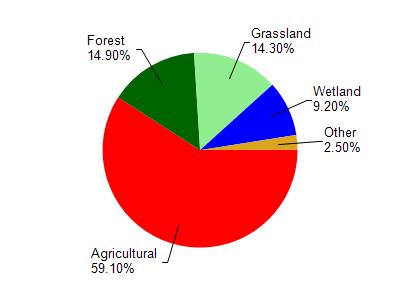Marathon
No
No
No
Fish and Aquatic Life
Historical Description
Elm Brook is classified as a limited forage fishery and limited aquatic life stream. Biotic index results indicated "very poor" water quality at a site a mile above the junction with Dill Creek. The Abbotsford WWTP, Stormwater run-off, may be responsible for degradation of water quality. The source of BOD-demanding materials is depleting oxygen in the stream.
Kreitlow, James D. 1991. Upper Wisconsin River Central Sub-Basin Water Quality Management Plan. PUBL-WR-287-91-REV. Wisconsin Department of Natural Resources, Madison, WI.
Date 1991
Author Aquatic Biologist
Condition
Wisconsin has over 84,000 miles of streams, 15,000 lakes and milllions of acres of wetlands. Assessing the condition of this vast amount of water is challenging. The state's water monitoring program uses a media-based, cross-program approach to analyze water condition. An updated monitoring strategy (2015-2020) is now available. Compliance with Clean Water Act fishable, swimmable standards are located in the Executive Summary of Water Condition in 2018. See also the 'monitoring and projects' tab.
Reports
Recommendations
Monitor Aquatic Biology
Conduct biological (mIBI or fIBI) monitoring on Elm Brook, WBIC: 1431500, AU:12405
Management Goals
Wisconsin's Water Quality Standards provide qualitative and quantitative goals for waters that are protective of Fishable, Swimmable conditions [Learn more]. Waters that do not meet water quality standards are considered impaired and restoration actions are planned and carried out until the water is once again fishable and swimmable
Management goals can include creation or implementation of a Total Maximum Daily Load analysis, a Nine Key Element Plan, or other restoration work, education and outreach and more. If specific recommendations exist for this water, they will be displayed below online.
Monitoring
Monitoring the condition of a river, stream, or lake includes gathering physical, chemical, biological, and habitat data. Comprehensive studies often gather all these parameters in great detail, while lighter assessment events will involve sampling physical, chemical and biological data such as macroinvertebrates. Aquatic macroinvertebrates and fish communities integrate watershed or catchment condition, providing great insight into overall ecosystem health. Chemical and habitat parameters tell researchers more about human induced problems including contaminated runoff, point source dischargers, or habitat issues that foster or limit the potential of aquatic communities to thrive in a given area. Wisconsin's Water Monitoring Strategy was recenty updated.
Grants and Management Projects
Monitoring Projects
| WBIC | Official Waterbody Name | Station ID | Station Name | Earliest Fieldwork Date | Latest Fieldwork Date | View Station | View Data |
|---|
| 1431500 | Elm Brook | 373265 | Elm Brook - 1st Tn Rd Bl Abtsford | 10/8/2019 | 8/6/2025 | Map | Data |
| 1431500 | Elm Brook | 373267 | Elm Brook at Cth N Near Colby | 5/1/1986 | 8/6/2025 | Map | Data |
| 1431500 | Elm Brook | 373150 | Elm Brook at Cth - N | | | Map | Data |
| 1431500 | Elm Brook | 373266 | Elm Brook - 2nd Tn Rd Bl Abtsford | 8/6/2025 | 8/6/2025 | Map | Data |
| 1431500 | Elm Brook | 10010885 | Elm Brook - Upstream Lincoln Rd | | | Map | Data |
| 1431500 | Elm Brook | 373389 | Elm Brook at Adams (Lincoln) St | 6/6/1989 | 8/6/2025 | Map | Data |
| 1431500 | Elm Brook | 10010884 | Elm Brook - Elm Brook Downstream Cth N - Station 1 | | | Map | Data |
|

Watershed Characteristics
Elm Brook is located in the Upper Big Eau Pleine River watershed which is 219.52 mi². Land use in the watershed is primarily agricultural (59.10%), forest (14.90%) and a mix of grassland (14.30%) and other uses (11.70%). This watershed has stream miles, lake acres and 10,255.86 wetland acres.
Nonpoint Source Characteristics
This watershed is ranked High for runoff impacts on streams, Low for runoff impacts on lakes and High for runoff impacts on groundwater and therefore has an overall rank of High. This value can be used in ranking the watershed or individual waterbodies for grant funding under state and county programs.However, all waters are affected by diffuse pollutant sources regardless of initial water quality. Applications for specific runoff projects under state or county grant programs may be pursued. For more information, go to surface water program grants.